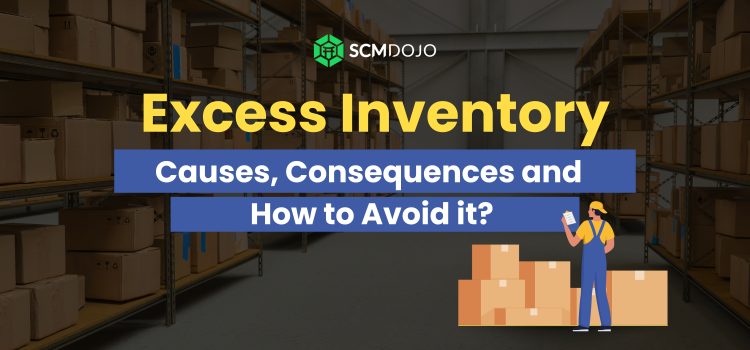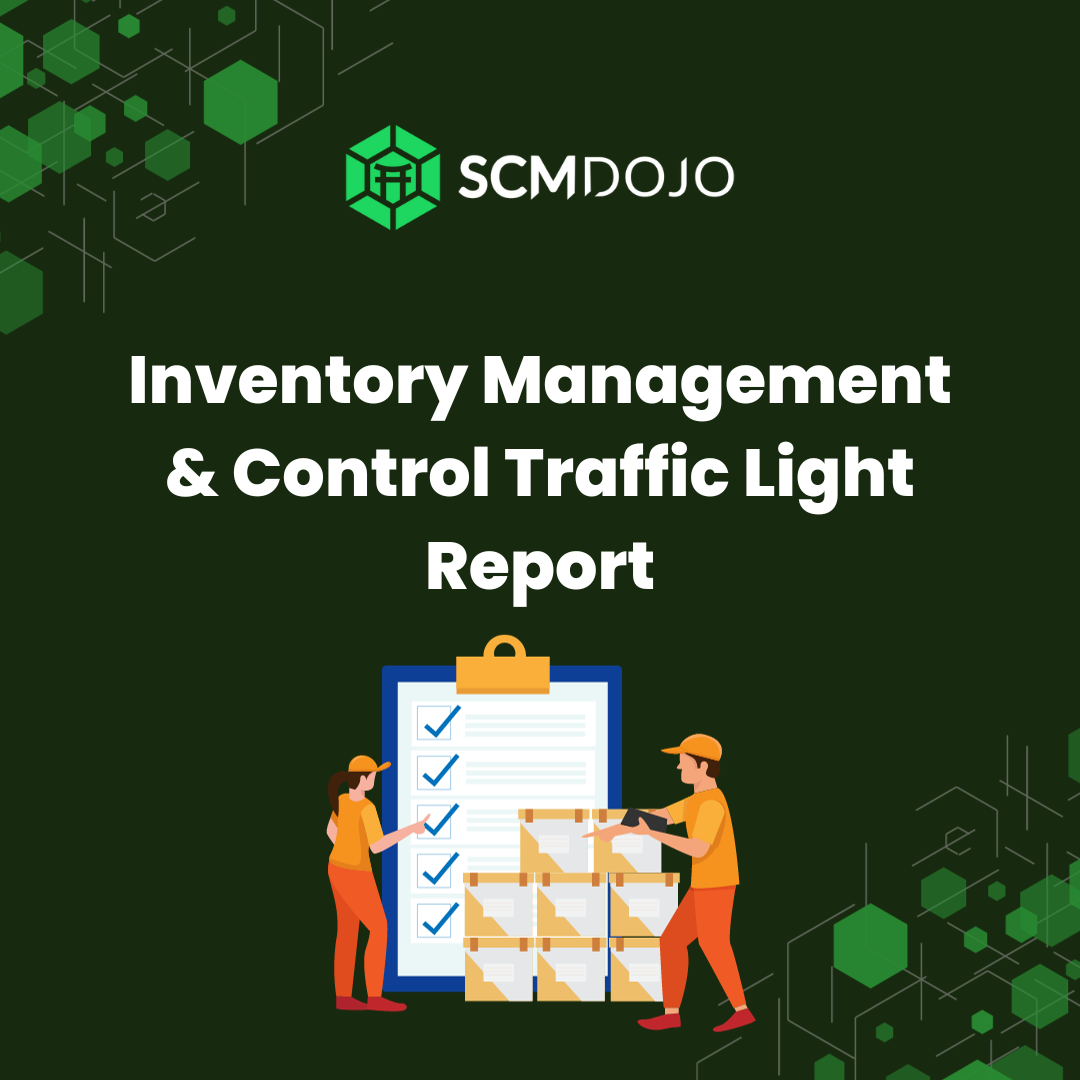In today’s fast-paced business world, excess inventory can be a major hindrance to growth and profitability. Whether it’s unsold products taking up valuable storage space or excess & obsolete items tying up capital, having excessive inventory can lead to increased costs and decreased cash flow. That’s why streamlining your inventory management strategies is crucial for success. In this article, we will explore effective techniques for clearing the clutter and optimizing your inventory levels.
Whether you’re a small business struggling with excess inventory or a large enterprise seeking to enhance efficiency, this article will equip you with the tools and insights necessary to clear the clutter and achieve optimal inventory levels. So, let’s dive in and start streamlining!
Read more on 10 Inventory Control Techniques That are Evergreen on our Website SCMDOJO!
What Causes Excess Inventory?
Understanding the root causes is the first step to streamline your inventory management and get rid of excess & obsolete items. Continue reading to delve deeper into the causes of excess inventory:
Forecasting Errors:
Inaccurate predictions of demand for products can lead to overordering or underordering, resulting in excess inventory. Factors such as seasonality, market trends, and changes in consumer behavior can make forecasting challenging.
Poor Inventory Management:
Inefficient inventory management practices, such as inadequate tracking systems, lack of real-time data, or ineffective communication between different departments, can contribute to excess inventory.
Supplier Issues:
Delays in the supply chain, disruptions in the production process, or unexpected increases in lead times can result in excess inventory. Dependence on a single supplier or lack of supplier reliability can also be contributing factors.
Changes in Demand:
Rapid shifts in consumer preferences, market trends, or unexpected events (such as a global pandemic) can lead to changes in demand. If a company fails to adapt quickly to these changes, excess inventory may accumulate.
Promotions and Discounts:
If sales promotions or discounts fail to generate the expected increase in demand, excess inventory may result. Offering products at reduced prices without accurately forecasting demand can lead to overstock.
Product Life Cycle:
Poor management of the product life cycle, such as introducing new products without phasing out old ones, can lead to excess inventory of outdated or obsolete items.
Economic Factors:
Economic downturns or recessions can impact consumer spending and lead to decreased demand. Companies that do not adjust their production and inventory levels accordingly may end up with excess stock.
Quality Issues:
Products that do not meet quality standards may be returned or held in inventory, resulting in excess stock. This can happen due to manufacturing defects, transportation damage, or other quality-related issues.
Lack of Communication:
Inadequate communication between different departments within a company, such as sales, marketing, and operations, can lead to misalignment between production and demand forecasts, contributing to excess inventory.
Ordering in Bulk:
While ordering in bulk can often result in cost savings, it also carries the risk of excess inventory if the demand does not meet the expected levels.
Embark on a journey to clear the clutter with our comprehensive exploration of these causes and discover effective strategies for optimizing your inventory management processes.
What are the Consequences of Excess Inventory?
Excess inventory can be caused by various factors, and it’s important to understand and address these underlying causes to effectively clear the clutter.
Storage Costs:
Storing excess inventory requires warehouse space, and the associated costs can be significant. Rent, utilities, insurance, and labor costs for managing and maintaining the inventory can all contribute to increased operational expenses.
Carrying Costs:
Carrying costs include expenses such as the cost of money tied up in the excess inventory, insurance, and taxes. The longer excess inventory sits in warehouses, the higher these carrying costs become, negatively impacting the company’s profitability.
Obsolete or Outdated Products:
Excess inventory may consist of products that become obsolete or outdated, especially in industries with rapidly changing technologies or trends. This can lead to significant losses as these products may need to be heavily discounted or written off.
Reduced Cash Flow:
Tieing up capital in excess inventory reduces the available cash for other critical business activities, such as investing in new opportunities, research and development, or debt reduction. This can constrain the company’s ability to respond to changes in the market.
Free Inventory Management And Control Traffic Light Report.xlsx
Discounting and Loss of Profit Margins:
To clear excess inventory, companies often resort to discounts and promotions, eroding profit margins. The need to sell products at lower prices to move inventory can impact the overall profitability of the business.
Decreased Efficiency:
Managing excess inventory can lead to operational inefficiencies. It may require additional labor to handle, track, and manage the surplus stock, diverting resources that could be used more efficiently elsewhere in the business.
Increased Holding Time:
Excess inventory may remain in storage for extended periods, tying up valuable resources and delaying the introduction of new products. This can hinder a company’s ability to stay competitive and innovative in the market.
Strain on Relationships with Suppliers:
Consistent overordering and excess inventory can strain relationships with suppliers, especially if they are left with unpaid invoices or if the company has trouble taking delivery of new orders. This can result in strained supplier relationships and potential disruptions in the supply chain.
Risk of Write-Offs:
If excess inventory cannot be sold, and its value depreciates over time, the company may have to write off the unsold stock as a loss, further impacting its financial statements.
Customer Dissatisfaction:
If excess inventory includes products that are later phased out or replaced, customers who purchased the older versions may become dissatisfied. This can harm the company’s reputation and customer loyalty.
How to Prevent Excess Inventory?
Effectively managing inventory is essential for a streamlined and profitable business. To prevent the pitfalls of excess inventory, proactive strategies must be implemented. Explore the following subheadings to discover actionable insights and proven methods for clearing the clutter and maintaining optimal inventory levels:
1. Demand Forecasting and Data Analytics:
In the ever-evolving landscape of commerce, accurately predicting customer demand is a crucial component of effective inventory management. Leverage advanced data analytics tools to analyze historical sales data, market trends, and seasonal patterns. By understanding the factors influencing demand, businesses can make informed decisions about the quantity of stock to maintain. Implementing robust demand forecasting not only helps prevent excess inventory but also ensures that products are available when customers need them.
2. Just-in-Time (JIT) Inventory Management:
Adopting a Just-in-Time (JIT) inventory management approach is a proactive strategy to prevent excess inventory. Instead of maintaining large stockpiles, businesses order goods and materials precisely when needed. This not only minimizes storage costs but also reduces the risk of overstocking. However, successful JIT implementation requires strong supplier relationships, reliable logistics, and a responsive production process. When executed effectively, JIT streamlines the supply chain, enhances efficiency, and prevents the accumulation of unnecessary inventory.
3. Supplier Collaboration and Communication:
Establishing open communication channels with suppliers is paramount to preventing excess inventory. Collaborate closely with suppliers to share real-time information on sales trends, upcoming promotions, and changes in demand. This collaborative approach allows suppliers to adjust their production schedules accordingly, preventing overproduction and reducing the likelihood of excess inventory. Building strong relationships with suppliers fosters a shared commitment to efficient inventory management and ensures a more agile and responsive supply chain.
Access our blog to learn more about ABC Classification in Inventory Management at our website SCMDOJO!
4. Regular Inventory Audits and Monitoring:
Regular inventory audits and monitoring are essential for maintaining control over stock levels. Implement a systematic approach to auditing inventory, including cycle counts, to identify discrepancies and address imbalances promptly. Real-time monitoring tools can provide insights into inventory turnover rates, allowing businesses to adjust ordering patterns and production schedules as needed. By staying vigilant and proactive, businesses can detect and mitigate potential excessive inventory issues before they escalate.
5. Flexible Ordering and Production Processes:
Flexibility is key to preventing excess inventory in a dynamic market. Implement agile ordering and production processes that can adapt to changes in demand and market conditions. Utilize technology and automation to streamline workflows and adjust production schedules in response to real-time data. By embracing flexibility, businesses can avoid the rigidity that often leads to overcommitment and excessive inventory, ensuring a more responsive and efficient operation.
6. Promotions and Marketing Strategies:
Strategic promotions and marketing initiatives play a pivotal role in preventing excessive inventory while stimulating sales. Implement targeted promotions based on inventory levels, seasonal trends, and customer preferences. By aligning promotions with demand, businesses can prevent stockouts without resorting to overstocking. Additionally, well-executed marketing strategies can create buzz around products, driving demand and helping to maintain a healthy balance between supply and demand. Embrace a data-driven marketing approach to ensure that promotional efforts align with inventory management goals.
7. Improve New Product Introduction Launches:
Improving the new product introduction process is crucial for minimizing excess inventory related to slow-moving or obsolete items. Here are some strategies to enhance the efficiency of new product introduction and reduce the risk of excessive inventory:
- Phased Launches: Implement a phased introduction of new products instead of a large-scale launch. This allows for better control over inventory levels, enabling adjustments based on initial market response.
- Pilot Programs: Conduct pilot programs or soft launches in specific regions or with a targeted customer segment to test the market and gather feedback before a full-scale rollout. This can help refine the product and adjust inventory plans accordingly.
- Flexible Manufacturing Processes: Develop flexible manufacturing processes that allow for quick adjustments in production volumes based on actual demand. This agility helps prevent overproduction and excess inventory.
Read more on the Importance of Inventory Management: 14 benefits you should know at our website SCMDOJO!
How SCMDOJO can help Manage Excess Inventory?
Navigating the complexities of excess inventory is a strategic challenge for businesses striving for streamlined operations. In the pursuit of clearing the clutter and optimizing your inventory management, SCMDOJO emerges as the ultimate ally. Our suite of best practice tools, targeted courses, and the expertise of seasoned professionals are tailored to resolve excessive inventory challenges efficiently.
Read more on Optimizing Inventory and Lead-Time Management at our website SCMDOJO!
1. Best Practice Tools for Inventory Optimization:
Embrace precision in inventory control with SCMDOJO’s Inventory Optimization tool. Predict demand fluctuations, optimize stock levels, and make data-driven decisions to prevent the accumulation of excessive inventory. Our tools act as a compass, guiding your business toward maintaining the delicate balance required for efficient supply chain management.
2. Courses for Skill Enhancement and Strategic Insight:
Knowledge is power, especially when it comes to managing excess & obsolete inventory. SCMDOJO’s courses, curated by industry experts, empower professionals with skills and strategic insights. Covering essential topics such as Modern Warehousing and distribution centers and the Basics of Inventory Management, these courses equip your team to navigate the complexities of the supply chain and proactively manage inventory.
3. Services of Experts for Tailored Solutions:
Recognizing the uniqueness of every business, SCMDOJO goes beyond tools and courses. Our experts collaborate closely with your team, conducting thorough assessments to identify specific pain points. Whether it’s implementing JIT strategies, optimizing supplier collaboration, or fine-tuning existing processes, our experts craft tailored solutions to address the root causes of excess & obsolete inventory challenges.
Dr. Muddassir Ahmed, an industry expert, offers his services for performing Inventory Optimizing Analysis.
4. EBook Guide: Unlocking Success in Inventory Management:
Complementing our suite of tools and services are our insightful eBook guides. This resource serves as a comprehensive manual, providing actionable strategies and proven techniques to effectively manage excess inventory. From understanding the impact to implementing proactive measures, the eBook is a valuable companion in your journey toward streamlined inventory management.
5. Educational Blogs for Continuous Learning:
Stay informed and engaged with SCMDOJO’s educational blogs. Our blog content provides valuable insights, industry trends, and actionable tips on managing excess inventory. It serves as a dynamic resource for continuous learning, keeping you updated on the latest developments in inventory management best practices.
Access our Blogs at our Website SCMDOJO
6. Proactive Strategies for Long-term Results:
Short-term fixes are not enough in the dynamic world of excess inventory management. SCMDOJO emphasizes proactive strategies that yield long-term results. From regular inventory audits to effective communication frameworks with suppliers, we guide your business for practices that prevent excess inventory issues in the long run.
7. Collaborative Learning Community:
SCMDOJO is more than a provider of tools and services; it’s a collaborative learning community. Join our network of supply chain professionals to share experiences, discuss challenges, and explore innovative solutions. This joint environment ensures that you stay informed about the latest industry trends, emerging technologies, and proven strategies for effective inventory management.
Follow us on LinkedIn, Facebook, Instagram, YouTube and Twitter.
Empowering Your Business with SCMDOJO:
In the pursuit of streamlining excess inventory, SCMDOJO stands as a reliable partner committed to unlocking success for your business. Whether you are looking to optimize inventory processes, enhance your team’s skills, or access expert guidance, SCMDOJO provides a comprehensive solution. As you embark on the journey towards efficient and strategic inventory management, let SCMDOJO be your guide—clearing the clutter and paving the way for long-term success.
Conclusion
Clearing the clutter of excess & obsolete inventory is a task that requires a strategic approach. By understanding the impact, recognizing the risks, and implementing effective strategies, businesses can streamline their inventory management processes, optimize resource allocation, and pave the way for long-term growth and profitability. Embrace these strategies to strike the right balance and keep excess inventory at bay.
Some Common FAQs related to Excess Inventory
Q: Why is excess & obsolete inventory a problem for businesses?
A: Excess inventory ties up capital, takes up valuable space, and can lead to obsolescence, reducing overall profitability.
Q: How can I determine if I have excessive inventory?
A: Regularly monitor sales trends, set appropriate reorder points, and use inventory turnover ratios to identify excessive stock.
Q: What are effective strategies for clearing excess & obsolete inventory?
A: Offer discounts, bundle products, run promotions, or explore partnerships to move excess inventory quickly.
Q: How can technology help manage excess inventory?
A: Utilize inventory management software to track stock levels, forecast demand, and automate reorder processes, minimizing the risk of excess inventory.
Q: How often should I reassess my inventory levels?
A: Regularly review and adjust inventory levels based on market trends, seasonal variations, and changes in customer demand.












